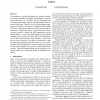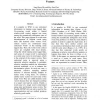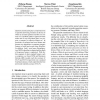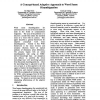126 search results - page 15 / 26 » Unsupervised word sense disambiguation using WordNet relativ... |
SDM
2009
SIAM
14 years 4 months ago
2009
SIAM
The annotation of words and phrases by ontology concepts is extremely helpful for semantic interpretation. However many ontologies, e.g. WordNet, are too fine-grained and even hu...
COLING
2002
13 years 7 months ago
2002
It is popular in WSD to use contextual information in training sense tagged data. Co-occurring words within a limited window-sized context support one sense among the semantically...
EMNLP
2008
13 years 8 months ago
2008
Question classification plays an important role in question answering. Features are the key to obtain an accurate question classifier. In contrast to Li and Roth (2002)'s app...
SAC
2009
ACM
14 years 2 months ago
2009
ACM
Incorporating background knowledge into data mining algorithms is an important but challenging problem. Current approaches in semi-supervised learning require explicit knowledge p...
ACL
1998
13 years 8 months ago
1998
Word sense disambiguation for unrestricted text is one of the most difficult tasks in the fields of computational linguistics. The crux of the problem is to discover a model that ...




